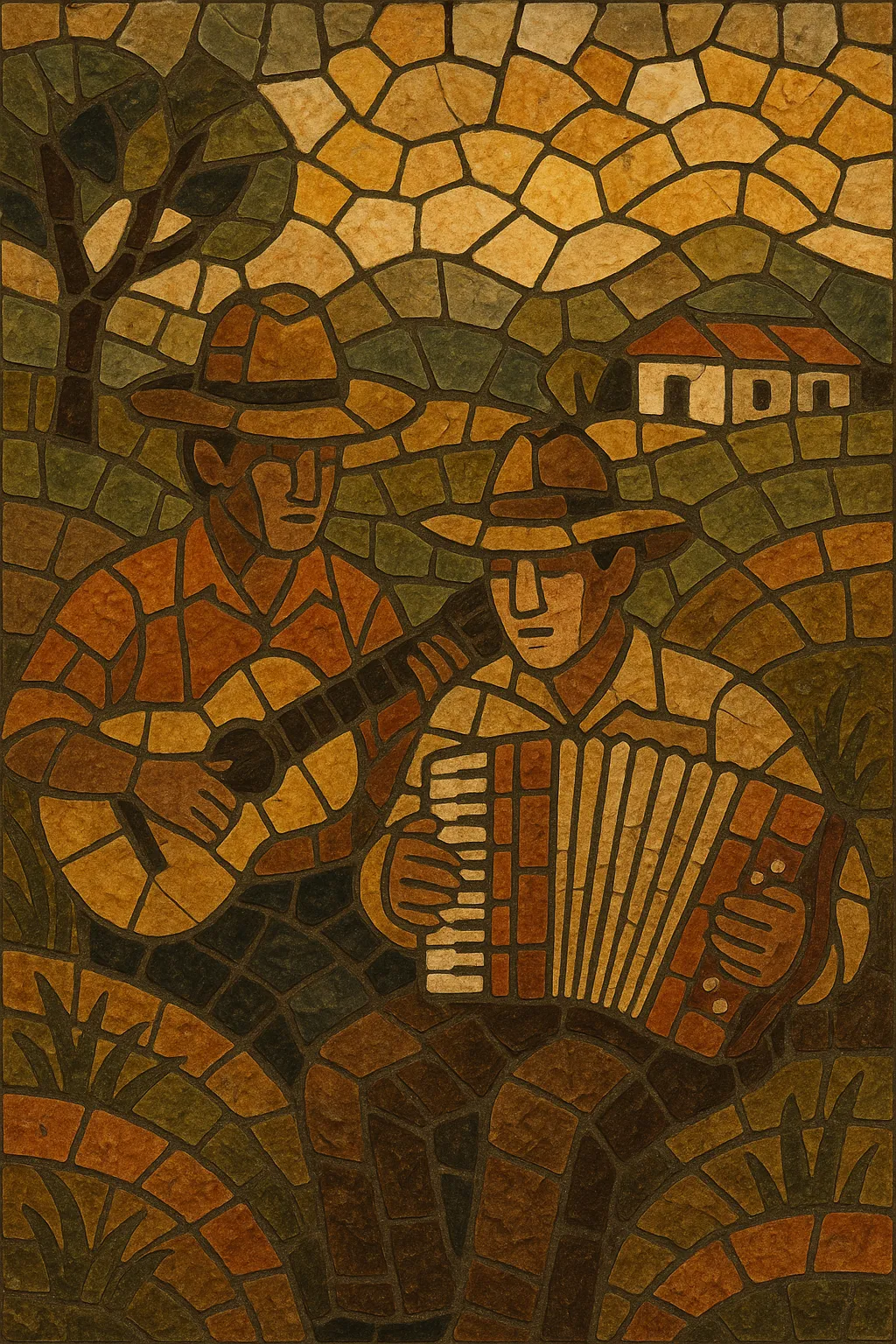Sertanejo raiz (also called música caipira) is the traditional, rural form of Brazilian country music that crystallized in the countryside of São Paulo, Minas Gerais, Goiás, and neighboring states. It is typically performed by vocal duos singing in parallel thirds (as chamadas "terças caipiras") accompanied by viola caipira (a 10‑string, 5‑course guitar) and violão (6‑string acoustic guitar), with occasional accordion and handclaps.
Its core song types include moda de viola (narrative ballads), toada, cururu, cateretê/catira (with foot‑stomping and clapping), and xote/schottische, reflecting Iberian and European dance roots blended with Brazilian rural poetics. Harmonies are simple (mostly I–IV–V with few extensions), melodies are singable and diatonic, and the lyrics dwell on nature, faith, love, friendship, roads and cattle‑drives, and especially saudade (nostalgic longing) for the countryside.
Música caipira formed from a blend of Iberian song (modinha), Afro‑Brazilian lundu, European ballroom dances (polka, waltz, schottische/xote), and Portuguese folk brought by settlers to Brazil’s interior. Duos with viola caipira and close‑harmonized vocals became the norm in rural festivities and religious gatherings.
In 1929, the folklorist Cornélio Pires financed the first 78 rpm sessions of caipira artists ("Turma Caipira Cornélio Pires"), establishing a commercial path for the rustic style and defining what would later be called sertanejo raiz.
Radio expanded the reach of caipira music, and iconic duos emerged. Tonico & Tinoco popularized the narrative moda de viola and became emblems of the genre. Cascatinha & Inhana brought Paraguayan polka/guarania colors into the repertoire. Tião Carreiro & Pardinho refined viola technique and introduced the lively "pagode caipira" feel while remaining rooted in the caipira vocabulary. This period fixed the aesthetics of parallel‑thirds harmony, story‑driven lyrics, and viola‑centered accompaniment.
Television and LPs helped both continuity and transformation. While more urban, romantic strands of sertanejo began to appear, many artists and programs kept raiz alive. Inezita Barroso became a national symbol and, as host of "Viola, Minha Viola" (1980–2015), preserved and disseminated the traditional repertoire, luthiers, and regional variants of the viola caipira.
Festivals, violeiro competitions, and educational initiatives revitalized the viola caipira and the raiz canon. Artists such as Pena Branca & Xavantinho and Almir Sater bridged raiz with contemporary audiences. Stylistically, sertanejo raiz remains the foundation for later branches of sertanejo and influenced the Brazilian "rock rural" movement of the 1970s, ensuring the countryside’s poetics and sound continue to resonate.
Use a viola caipira (10 strings in 5 courses) in common tunings like Cebolão (in E or D), Rio Abaixo, or Boiadeira. Pair it with a violão (6‑string acoustic) providing bass runs (baixarias) and rhythmic strumming. Add accordion for color, and handclaps/foot‑stomps (catira) for dance pieces. Keep the sound acoustic, warm, and intimate.
Favor diatonic major/minor keys with simple I–IV–V progressions and occasional V/V or II7 as a passing dominant. Avoid dense extensions; the style’s strength is clarity. Write melodies that sit well in the voice and outline chord tones. For duos, employ “terças caipiras”: the segunda voz (upper harmony) tracks the melody mostly in parallel thirds or sixths, entering on cadences and key phrases.
Alternate between narrative, moderate‑tempo modas (often 2/4 or 4/4) and dance‑derived pieces (xote/schottische, cateretê/catira). Maintain a steady pulse; use viola ponteado (arpeggiated picking) for ballads and batido (strum) for livelier numbers. Typical tempos range roughly from 60–120 BPM.
Write in plain, imagery‑rich language about rural life: dawns, rivers, cattle, roads, friendship, faith, and saudade for the sertão. Strophic forms work best; use quatrains, redondilhas (7‑syllable lines), or décima‑style stanzas. Let the story unfold verse by verse, with a memorable refrain.
Feature a vocal duo: the primeira voz carries the melody; the segunda voz adds close harmony. Introduce instrumental interludes on viola (bridges, intros, codas). Keep dynamics organic—soft storytelling verses, brighter refrains—and consider call‑and‑response for cururu/catira pieces. Record with minimal processing to preserve the wood‑and‑string character.


